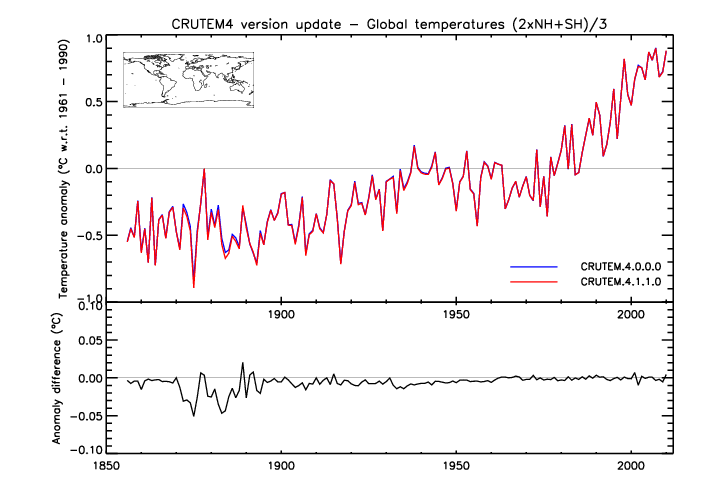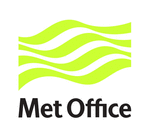
| Met Office Hadley Centre observations datasets |
| > Home > CRUTEM4 > Versions > |
See below for detailed information about data updates included in version CRUTEM.4.1.1.0 and diagnostic plots showing the effects of the updates on global and regional time series.
Data for CRUTEM.4.1.1.0 can be found here.
Before going into the individual details, it is necessary to bear in mind the following issues that are often involved with subsets of data produced by national met. agencies or through other initiatives for climate studies:
For the purposes of merger into the CRUTEM archive, it is necessary to have consistency between the WMO-style (WMO or pseudo-WMO) ID codes used by CRUTEM and those applied to the "new" series. Some climate-series providers use their own domestic ID codes for example, GHCN, Canada and Australia. This requires a matching exercise so that appropriate ID codes are applied. However, there is a further consideration that it is preferable that CRUTEM series use the "current" WMO codes so that as many series as possible can be updated routinely via CLIMAT and MCDW circulations. This is important because the extensive updating of climate series may only be undertaken sporadically by the national agencies.
However, this adds a further consideration. Long climate series are often produced from the records of different met. stations, with (homogeneity) adjustment as necessary. Ideally, the series are all adjusted to the last (current) met. station record. This ensures that near real-time updates (from CLIMAT/MCDW) are compatible with the earlier record. In practice, this is not always the case so routine monthly updates may subsequently be replaced by series received from the climate-series providers.
Finally, when datasets for climate studies are merged with the CRUTEM archive, it is possible that, following the merger, some resultant series are longer (start earlier) than the received series. We have a general principle that the resultant series should be retained so long as the early subset (pre-new series) is compatible (from a homogeneity perspective) with the new. Simple tests are conducted to check the compatibility.
The USHCN dataset was downloaded from http://cdiac.ornl.gov/epubs/ndp/ushcn/access.html . The same core of series was present - as compared with the previous downloading/incorporation exercise in August 2010. After a repeat of the previous processing/matching exercise, 1059 series were merged with the archive - giving priority to the new series. On checking differences between old and new overlapping subsets of data, it is evident that there have been some changes to the USHCN series - other than their updating to the end of 2011. The same source code (44) as that used previously was retained.
The Russian climate series were downloaded via http://meteo.ru/climate/sp_clim.php (http://cdiac.ornl.gov/epubs/ndp/ushcn/access.html). The number of series acquired was 518. However, after processing and matching with existing archive contents, it was found that only three of the 518 series were new to the CRUTEM archive. In the merger checks, it was found that there were differences between old and new versions of overlapping subsets. This shows that further QC changes have been made by the Russian Federation since the previous incorporation of their data series in 2010. The new series were given priority in the latest merger and the source code 43 was retained. However, this action has changed significant numbers of Russian-series source codes as many of the series with source code 51 have been overwritten and thus acquired source code 43. The number of series with source code 51 has fallen from 213 to 75.
The Canadian climate series were supplied by Environment Canada (EC) via a direct communication in February 2012. A total of 338 series were received. The EC climate series are available from http://www.ec.gc.ca/dccha-ahccd/. While Environment Canada do not use WMO codes in this context, the vast majority of the series supplied do have WMO codes. The matching exercise was quite complex as some WMO codes have changed and several of the EC series are now adjusted (see introduction) to a new current record. At the end of the matching exercise, unmatched series were given pseudo-WMO codes. In addition, it was noticed that CRUTEM had some duplicate series (under different names/ID codes, but usually of different length). Some rationalization was undertaken with the removal of secondary duplicate series.
Of the 338 series received, 226 series were matched (through domestic ID codes and/or using location details) with existing series in CRUTEM and given the CRUTEM ID codes. The remaining 112 "new" series either received WMO codes (after searches with EC and WMO listings) or were allocated pseudo-WMO codes. In a further exercise to update the ID codes used for Canadian stations in CRUTEM (see introduction above) 50 of the Canadian WMO IDs were changed after consulting recent CLIMAT and MCDW holdings. Finally, the cases of duplicate presence were dealt with. In each of the seven cases where a series under a pseudo-WMO ID code and one from the same location under a WMO ID-code were identified, the series under the pseudo-WMO ID code was removed. The final total of Canadian series in the archive is 446. The source code 42 was retained for all series coming from EC. The merger-differences record (differences between old and new versions for common periods) shows that significant changes have been made to many of the new series - often due to the adoption (and thus adjustment to) new end-point records. Full details of the Canadian adjustments are given in Vincent et al. (2012).
Australian updates were taken from (firstly): ftp://ftp.bom.gov.au/anon/home/ncc/www/change/HQdailyT . The processing repeated the steps taken in 2006 when the "High Quality" series from the Bureau of Meteorology (BoM) were first incorporated into CRUTEM. The (103) series present were found to coincide with what was present in 2006 except that many had received updates. This made the matching/processing straight-forward. On merger with the CRUTEM archive (the latest downloads having priority), some differences were apparent throughout the period of overlap between old and new versions. This indicates that BoM had made some further QC changes since 2006. More discussion on the differences in Australian reporting of average temperatures is given in Trewin (2004).
The second source of updates came from the BoM monthly circulations of monthly nationwide Tmax and Tmin that are sent directly to the Climatic Research Unit (CRU) on a regular basis. The reason for the use of these files is that until recently, the values of Tmean supplied by BoM for the CLIMAT and MCDW monthly circulations, were derived from daily averages calculated as the mean of multiple hourly readings as opposed to the more conventional (Tmax + Tmin)/2. While the CRUTEM archive is routinely updated from CLIMAT/MCDW, there has been a question of continuity (homogeneity) concerning these operational updates. On a periodic basis, CRU has extracted the appropriate values from the direct BoM circulations and substituted these values into CRUTEM after the recalculation of Tmean as (Tmax+Tmin)/2.
The (above) two sets of series were merged (the HQ values having priority) before the resultant series (366 in number) were merged with CRUTEM - with priority going to the new 366-member collection of series. Due to the brevity of the series extracted from the Tmax and Tmin files (2006-11), no new series were added to CRUTEM - only the ones that matched were retained. The source code 40 was also retained.
UK station updates were obtained, as previously, from: http://www.metoffice.gov.uk/climate/uk/stationdata/ . Seven series were updated only. The downloaded series were truncated to the period 2005-11 and these were given priority in the merger. The source code 45 was retained.
Ponta Delgada (Azores) updates came via direct contacts in the Azores Met. Office. The record for station WMO-code 08513 has a very patchy record in recent years through the routine updating from CLIMAT/MCDW. Data have been obtained for station 08512 and the two records combined under ID code 08512 to replace missing values where possible and the code change enhances the prospect of future updates via CLIMAT/MCDW.
Ten homogenized series for the Netherlands have been received through direct contact at their Met. administration (KNMI). After processing, the series were merged with the CRUTEM archive - the new series having priority. Source code 55 was allocated. There is information regarding efforts to produce homogenized climate series in the Netherlands in Schrier et al. (2011). In addition, it is possible to obtain all ten homogenized series via KNMI Climate Explorer (http://climexp.knmi.nl/start.cgi?id=someone@somewhere).
References:
Schrier, G. van der, A.P. van Ulden and G.J. van Oldenborgh, (2011) The construction of a Central Netherlands temperature Climate of the Past, 7, 527-542, doi:10.5194/cp-7-527-2011.
Trewin, BC. (2004). Effects of changes in algorithms used for the calculation of Australian mean temperature. Aust Meteorol Mag, 53: 1-11.
Vincent, L. A., X. L. Wang, E. J. Milewska, H. Wan, F. Yang, and V. Swail (2012), A second generation of homogenized Canadian monthly surface air temperature for climate trend analysis, J. Geophys. Res., 117, D18110, doi:10.1029/2012JD017859.
This version of CRUTEM4 introduces monthly updates of the dataset from quality controlled CLIMAT messages and from Monthly Climatic Data for the World publications. These updates are described in the CRUTEM4 paper. Each monthly update incorporates CLIMAT data for the 12 months running up to and including the most recent complete calendar month. MCDW data corresponding to months within this update window are incorporated into the dataset as they becomes available, typically 4-6 months later than CLIMAT messages. The monthly update system has been used to incorporate CLIMAT and MCDW data from January 2010 onwards.
The following diagnostic plots show comparisons of global and hemispheric time series for CRUTEM.4.1.1.0 (this version) and CRUTEM.4.0.0.0 (the initial CRUTEM4 release).
The following diagnostic plots show comparisons of regional average time series for CRUTEM.4.1.1.0 (this version) and CRUTEM.4.0.0.0 (the initial CRUTEM4 release).
Commercial and media enquiriesYou can access the Met Office Customer Centre, any time of the day or night by phone, fax or e-mail. Trained staff will help you find the information or products that are right for you. |
 |
Maintained by: Colin Morice |
© Crown Copyright |